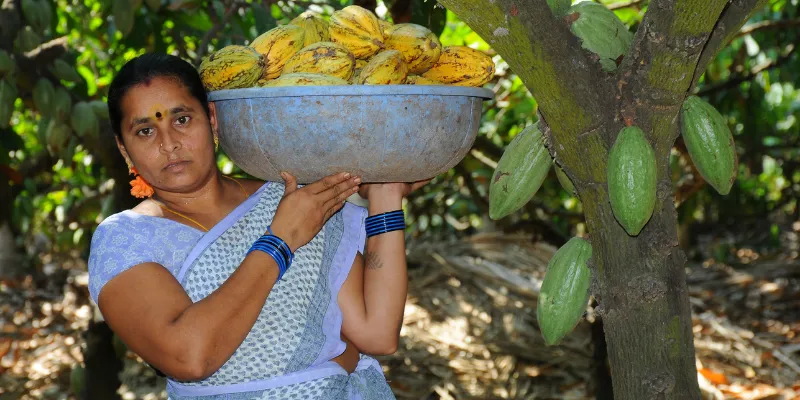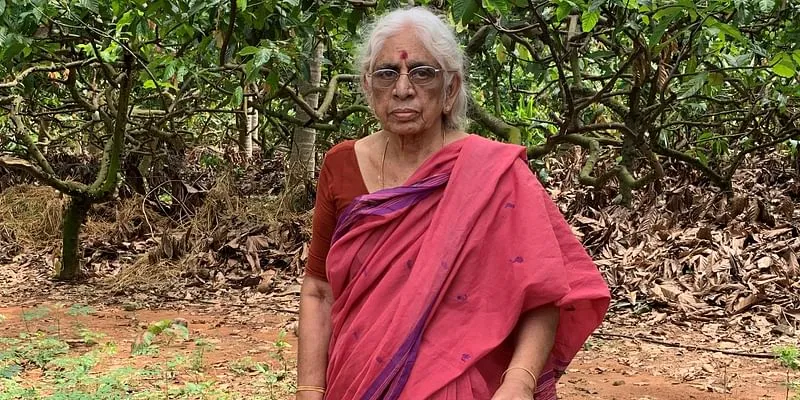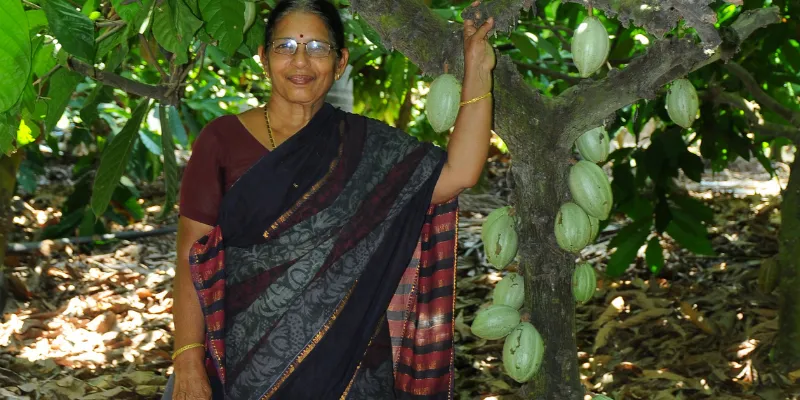How cocoa farming has helped these women farmers improve their livelihoods and increase income
Garapati Jhansi and Arimanda Samrajyam are two among hundreds of women farmers in India who have benefitted from cocoa farming through Mondelez India’s Cocoa Life programme.
This is the story of how a crop not indigenous to India is now improving the livelihoods and increasing farmer income in India.
Cocoa was introduced in India around 55 years ago at an experimental cocoa farm in Kerala by Mondelez India (earlier known as Cadbury India Ltd).

A coca farmer at work
As cocoa became a viable crop, its adoption extended to the neighbouring states of Tamil Nadu, Andhra Pradesh, and Karnataka. Today, around 100,000 cocoa farmers are thriving, diverse and inclusive communities, part of Cocoa Life's sustainability programme.
As cocoa is grown as an intercrop under multiple cropping systems, farmers can double their income levels. Also, it has helped them to have sustained income throughout the year as the cropping pattern varies between cocoa and other intercrops.
As part of the programme, Mondelēz International has invested $400 million over 10 years to empower cocoa farmers and improve people's lives in cocoa communities. The goal is that by 2025, all Mondelēz International’s chocolate brands will source their cocoa requirements through the Cocoa Life programme.
Beyond farming, the programme has trained over 5,000 women exclusively on health and hygiene, livelihood, and empowerment.
Over 6,400 children across schools in cocoa communities have benefitted from desks/benches and water supply infrastructure, making school attendance a comfortable experience. More than 5,600 tribal farmers have also been integrated into the rural economy by specific programmes developed to take up farming and cultivate cocoa in particular.
HerStory speaks to two women cocoa farmers from West Godavari District in Andhra Pradesh to understand how inter-cropping with cocoa has changed their lives for the better.
Garapati Jhansi, Bapirajugudem

Garapati Jhansi, cocoa farmer
Seventy-nine-year-old Garapati Jhansi from Bapirajugudem village in West Godavari District in Andhra Pradesh was born in an agricultural family, but has been active in agriculture and their farm only after her husband’s retirement.
They bought the land in 1988, planted coconut trees in 1990, followed by cocoa in 2000.
Explaining why they decided to plant cocoa, she says: “Before planting cocoa, the coconut income was not remunerative. Also, short time intercrops like bananas were not sustainable and were more sensitive to climatic calamities like cyclones, etc. Cocoa was the only right option for intercropping, which was introduced to us by Cadbury India (now Mondelez India). Their Cocoa Life team supported us by providing seedlings, technical support, and market support.”
She adds that cocoa cultivation is easy to manage as the plants are sturdy, and good yields were reported and recommended by existing cocoa farmers. Add to it, she followed good agricultural practices such as timely and proper pruning, nutrient management, pest and disease management, and best post-harvest management practices, from regular interactions with the Mondelez team.
Her 2,500 cocoa trees yield about 8,000 kg, an average of 3.2 kg per tree that she predominantly supplies to Mondelez India. This gives Jhansi a sustainable additional income without disturbing the main coconut crop.
Jhansi hopes to continue with best practices in the farm, and sustain it as a model farm and make it profitable.
Arimanda Samrajyam, Kondalaraopalem

Arimanda Samrajyam, a cocoa farmer
Arimanda Samrajyam (67) from Kondalaraopalem in West Godavari district, Andhra Pradesh, stood first in her SSLC (Class 10) exams. However, hailing from a family of agriculturists, she decided to take up farming as an occupation.
“I inherited 17.5 acres land where my father had first planted cocoa in 2002. Since 2005, I have taken up all the responsibilities of the farm,” she says.
Before planting cocoa, coconut income was the only source of income for the family; however, it was not very profitable.
“We wanted to get some additional income from the farm, which would help us support our family and farm better. Existing cocoa farmers recommended the crop, and support from Cadbury India (now Mondelez India) in cocoa farming and marketing prompted my father to take up cocoa. Our area is well suited for cocoa cultivation and is giving best and sustained production, since years, without disturbing the coconut plantation,” she says.
Samrajyam says Mondelez India's technical team provides special attention and encouragement to women farmers.
“We are delighted with Mondelez India for the guaranteed market support for our cocoa produce-direct farm-gate procurement as and when the product is ready for sale and their payment system. All good agricultural practices are followed in my farm such as timely and right pruning, nutrient management, etc. and best post-harvest management practices to get the better price for the produce,” she says.
Samrajyam gets 500 kg per acre/per annum from my 17.5 acres - around 2.8 kg per tree. She supplies her total yield to Mondelez India.
“Though we planted cocoa as an intercrop to get some additional income, the income on cocoa has surpassed the main crop (coconut). I managed to develop my farm as a model farm in the male-dominated farming culture. Managing the farm alone and achieving the best results has been both my biggest challenge and success,” Samrajyam adds.
Edited by Megha Reddy







